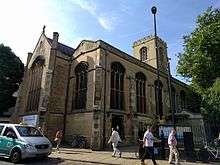St Andrew the Great
| St Andrew the Great | |
|---|---|
 | |
| Country | United Kingdom |
| Denomination | Church of England |
| Churchmanship | Low Church / Conservative Evangelical |
| Website | stag.org |
| Administration | |
| Diocese | Diocese of Ely |
| Clergy | |
| Vicar(s) | Alasdair Paine |
St Andrew the Great is a Church of England parish church in central Cambridge. The church has a conservative evangelical tradition and participates in the Anglican Reform movement.[1] The congregation includes Cambridge residents, overseas visitors and students from Cambridge University. The vicar is Alasdair Paine. Former vicars include Mark Ashton.[2]
Activities
The church is open for public services every Sunday: 10am, 11.30am (during University term time) and 5pm. Services are roughly an hour in length, with a strong emphasis on relevant Bible teaching. There are six age-banded Sunday school groups for children and also evening meetings for undergraduates (Tuesdays), 20s-30s (Wednesdays), internationals (Thursdays) and teenagers (Fridays and Sundays).[3]
History

A church on the site of St Andrew the Great is first mentioned by name in 1200AD. Little is known of the first building, which was probably a wooden structure, and was replaced with a more substantial stone building in the early 13th century. During the 16th century the church was a centre of Reformation preaching, with William Perkins the "lecturer" from 1585-1602.[4]
A third building was built on the site after 1650, largely at the expense of Christopher Rose (twice mayor of Cambridge, in 1637 and 1654). To accommodate a growing congregation, the building was entirely rebuilt in 1842, to a 15th century East Anglian style by Ambrose Poynter.[5]
St Andrew's was declared redundant in 1984[6] as the parish population had dwindled. However, the congregation of the Holy Sepulchre (the Round Church), was looking for a new home; they had met at "The Round" for over 800 years but congregational growth led them to run out of space. They raised the money to renovate St Andrew the Great, installing a new gallery, baptistry and rooms, and moved there in 1994. The parish associated with the church is now officially known as Holy Sepulchre with All Saints. The Round Church is still used occasionally and is leased to Christian Heritage for exhibition and training courses.
The church has been involved in three church 'grafting' schemes, to All Saints', Little Shelford (1997), Christ Church Cambridge (2004) and St Matthew's Cambridge (2008). In each case a minister on the staff moved with a substantial number in the congregation to join the existing congregation in those places.[7]
The church is within the Conservative Evangelical tradition of the Church of England, and it has passed resolutions to affirm a complementarian understanding of women's ministry.[8]
Cook Memorial

The church building contains a number of memorial tablets, most notably one of the explorer Captain James Cook. The memorial records Captain Cook, his wife Elizabeth, and their six children. Elizabeth died in 1835, aged 93, and was buried in the church.[9]
References
- ↑ Local churches linked to Reform
- ↑ Mark Ashton obituary
- ↑ St Andrew the Great website
- ↑ Ferguson, Sinclair (1996), "Foreword", The Art of Prophesying, Banner of Truth Trust, Edinburgh. ISBN 0851516890.
- ↑ Bradley, Simon. "Poynter, Ambrose". Oxford Dictionary of National Biography (online ed.). Oxford University Press.
- ↑ History of St Andrew the Great
- ↑ Ash, Christopher, Davis, Mary and White, Bob (2012). "Persistently Preaching Christ", p. 123. Christian Focus Publications, Fearn. ISBN 9781845509828.
- ↑ "Christmas 2016 Newsletter" (pdf). bishopofmaidstone.org. December 2016. Retrieved 1 January 2017.
- ↑ Captain Cook Society
External links
Coordinates: 52°12′18″N 0°07′18″E / 52.205°N 0.1217°E